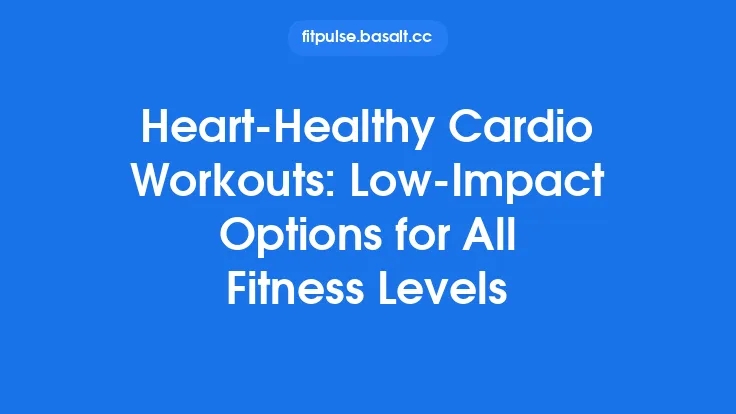VO₂ max, or maximal oxygen uptake, is the gold‑standard metric for aerobic capacity. It quantifies the highest rate at which the body can transport and use oxygen during intense, whole‑body exercise, expressed in milliliters of oxygen per kilogram of body weight per minute (ml·kg⁻¹·min⁻¹). Because oxygen delivery and utilization are central to endurance performance, VO₂ max serves as a reliable proxy for cardiovascular fitness, metabolic health, and even longevity. While the absolute number is useful on its own, its true value emerges when placed against age‑ and fitness‑specific benchmarks. These reference ranges help athletes, clinicians, and casual exercisers gauge where they stand, set realistic goals, and track progress over time.
Understanding VO₂ Max and Its Significance
VO₂ max reflects the integrated efficiency of three physiological systems:
- Pulmonary Function – the ability of the lungs to oxygenate blood.
- Cardiac Output – the heart’s capacity to pump oxygen‑rich blood to working muscles.
- Peripheral Utilization – the muscle’s mitochondrial density and enzymatic pathways that convert oxygen into adenosine triphosphate (ATP).
When any of these components is limited, VO₂ max plateaus. Consequently, improvements in training that target heart stroke volume, capillary density, or mitochondrial biogenesis can raise the ceiling. Because VO₂ max is highly correlated with endurance performance (e.g., running, cycling, swimming), it is frequently used to:
- Classify fitness levels (sedentary, recreational, competitive, elite).
- Predict health outcomes – higher VO₂ max is associated with reduced risk of cardiovascular disease, type 2 diabetes, and all‑cause mortality.
- Guide training prescription – athletes can tailor interval intensities to a percentage of their VO₂ max.
Age‑Based VO₂ Max Norms
Aging inevitably reduces maximal aerobic capacity, primarily due to declines in maximal heart rate, stroke volume, and muscle oxidative capacity. Large population studies have produced age‑specific reference tables that are widely accepted in sports science and clinical practice. Below is a synthesis of the most commonly cited ranges, expressed as average values for each decade. Individual values can vary widely, but these figures provide a useful backdrop.
| Age (years) | Men – Average VO₂ max (ml·kg⁻¹·min⁻¹) | Women – Average VO₂ max (ml·kg⁻¹·min⁻¹) |
|---|---|---|
| 20‑29 | 45‑55 | 35‑45 |
| 30‑39 | 42‑52 | 33‑43 |
| 40‑49 | 38‑48 | 30‑40 |
| 50‑59 | 34‑44 | 27‑37 |
| 60‑69 | 30‑40 | 24‑34 |
| 70‑79 | 26‑36 | 21‑31 |
Key observations
- Linear decline: VO₂ max typically drops about 1 % per year after the third decade of life, though the rate can accelerate after 60 years.
- Sex difference: Men generally record 10‑15 % higher values, reflecting larger hemoglobin mass, higher cardiac output, and greater muscle mass.
- Wide variability: Even within a single age group, values can span 15‑20 ml·kg⁻¹·min⁻¹, underscoring the influence of genetics, training history, and lifestyle.
Fitness Level Categories and Expected Ranges
To translate raw VO₂ max numbers into actionable insight, most fitness professionals map them onto fitness level categories. The following table aligns typical VO₂ max ranges with descriptive labels for both men and women. These categories are deliberately broad to accommodate individual variation.
| Fitness Category | Men (ml·kg⁻¹·min⁻¹) | Women (ml·kg⁻¹·min⁻¹) |
|---|---|---|
| Sedentary / Low | < 35 | < 28 |
| Below Average | 35‑40 | 28‑33 |
| Average | 40‑45 | 33‑38 |
| Above Average | 45‑50 | 38‑43 |
| Excellent / Competitive | 50‑55+ | 43‑48+ |
| Elite Endurance Athlete | 60‑70+ | 55‑65+ |
Interpretation tips
- Relative vs. absolute: The tables use relative VO₂ max (per kilogram body weight). For athletes with high body mass (e.g., powerlifters), absolute VO₂ max (L·min⁻¹) may be a more appropriate comparison.
- Training status matters: A 30‑year‑old recreational runner may fall into the “Average” band, while a similarly aged triathlete could be “Excellent.”
- Health implications: Even a modest increase from “Sedentary” to “Below Average” can confer measurable reductions in cardiovascular risk.
Gender Differences in VO₂ Max Benchmarks
While the tables above already separate men and women, it is useful to understand why the gap exists and how it influences benchmark interpretation.
- Hemoglobin concentration – Men typically have 15‑16 g/dL versus 13‑14 g/dL in women, allowing greater oxygen transport per unit of blood.
- Cardiac dimensions – Larger left‑ventricular volumes in men translate to higher maximal stroke volumes.
- Muscle fiber composition – Men often possess a higher proportion of type IIA fibers, which are highly oxidative.
- Body composition – Women generally have a higher percentage of body fat, reducing the relative VO₂ max when expressed per kilogram of total body mass.
Because of these physiological differences, direct comparisons across sexes are not advisable. Instead, each individual should be evaluated against the gender‑specific benchmarks that reflect typical physiological capacity.
How to Interpret Your VO₂ Max Score
When you receive a VO₂ max reading—whether from a laboratory treadmill test, a cycle ergometer, or a validated wearable device—follow this three‑step framework:
- Normalize for Age and Sex
Locate the appropriate age‑sex bracket in the tables above. Determine whether your value falls below, within, or above the average range.
- Contextualize with Activity Level
Align the number with the fitness‑level categories. If you are a regular endurance athlete but your score lands in the “Average” band, it may signal a plateau or a need for more specific training stimuli.
- Set a Target Increment
Research shows that a 5‑10 % increase in VO₂ max yields noticeable performance gains and health benefits. Use this as a realistic short‑term goal rather than aiming for elite values immediately.
Using Benchmarks to Set Training Goals
Benchmarks are most powerful when they become the foundation of a periodized training plan. Here’s a practical workflow:
| Goal | Target VO₂ Max Increase | Training Focus | Example Sessions |
|---|---|---|---|
| Maintain health (sedentary → below average) | +5 % | Moderate‑intensity continuous training (MICT) 30‑45 min, 3‑4 × week | Brisk walking, easy cycling |
| Improve recreational performance (average → above average) | +8‑12 % | High‑intensity interval training (HIIT) + steady‑state runs | 4 × 4 min intervals at 90‑95 % HRmax, 2 × 60 min long runs |
| Prepare for competition (above average → elite) | +15‑20 % | Polarized training (≈80 % low intensity, 20 % high intensity) + strength/power work | 5‑6 × week schedule with 2 HIIT days, 3 low‑intensity long rides, 1 strength session |
Why the percentages matter: VO₂ max improvements are not linear. Early gains (first 5‑10 %) are often achieved through increased training volume and basic interval work. Subsequent gains require more sophisticated stimuli—such as altitude simulation, high‑intensity sprint intervals, or targeted strength training—to push the cardiovascular and muscular systems beyond their current limits.
Progress Monitoring and Re‑Testing Frequency
Because VO₂ max can fluctuate with training load, illness, and lifestyle changes, regular re‑assessment is essential for accurate benchmarking.
| Training Phase | Recommended Re‑Test Interval |
|---|---|
| General fitness (maintenance) | Every 12 months |
| Focused improvement (6‑12 week block) | Every 8‑10 weeks |
| Elite preparation (periodized cycles) | Every 4‑6 weeks (lab test) or after each macro‑cycle (wearable estimate) |
Best practices for re‑testing
- Standardize conditions – Same time of day, similar pre‑test nutrition, and comparable environmental temperature.
- Use the same modality – If your baseline was measured on a treadmill, repeat on a treadmill; cross‑modality comparisons can introduce error.
- Allow adequate recovery – Ensure at least 48 hours of low‑intensity activity before the test to avoid fatigue‑induced underestimation.
Common Pitfalls and Limitations of VO₂ Max Benchmarks
While VO₂ max is a robust metric, it is not without constraints:
- Genetic ceiling – Approximately 25‑30 % of VO₂ max variability is hereditary. Some individuals may plateau despite optimal training.
- Body‑mass influence – Relative VO₂ max penalizes heavier athletes. For sports where body mass is advantageous (e.g., rowing), absolute VO₂ max may be more relevant.
- Testing protocol differences – Treadmill protocols (Bruce, Balke) can yield slightly higher values than cycle ergometer tests due to larger muscle mass involvement.
- Acute factors – Illness, sleep deprivation, dehydration, and high ambient temperature can depress VO₂ max temporarily.
- Device accuracy – Consumer wearables estimate VO₂ max using algorithms based on heart rate and speed; while convenient, they can have a margin of error of ±10‑15 %.
Understanding these limitations helps prevent over‑interpretation and keeps the focus on trend analysis rather than isolated numbers.
Practical Tips for Improving VO₂ Max
If your benchmark indicates room for growth, consider integrating the following evidence‑based strategies:
- Interval Training – Repeated bouts of 3‑5 minutes at 90‑95 % of maximal effort, interspersed with equal or slightly longer recovery, are the most efficient stimulus for raising VO₂ max.
- Increase Weekly Volume – Adding 10‑20 % more low‑intensity aerobic minutes per week can boost mitochondrial density, indirectly supporting VO₂ max.
- Strength‑Endurance Hybrids – Heavy‑load, low‑rep resistance work (e.g., squats, deadlifts) improves cardiac contractility and muscle oxidative capacity.
- Altitude or Hypoxic Training – Short‑term exposure to reduced oxygen (e.g., 2‑3 hours at 2,000 m) can stimulate erythropoietin production, enhancing oxygen transport.
- Optimize Nutrition – Adequate iron status, omega‑3 fatty acids, and carbohydrate availability support both oxygen transport and mitochondrial function.
- Prioritize Recovery – Sufficient sleep, active recovery sessions, and periodized rest weeks prevent chronic fatigue, which can blunt VO₂ max adaptations.
Bottom Line
VO₂ max benchmarks provide a clear, quantifiable yardstick for assessing aerobic fitness across the lifespan. By situating an individual’s value within age‑ and gender‑specific norms, and then mapping it to fitness‑level categories, users can:
- Recognize where they stand relative to peers.
- Set realistic, data‑driven training objectives.
- Monitor progress with scientifically grounded re‑testing intervals.
- Identify when a plateau may be due to genetic limits versus modifiable factors.
When used thoughtfully—acknowledging its limitations and complementing it with sound training principles—VO₂ max becomes more than a number; it becomes a roadmap for healthier, more capable living.





